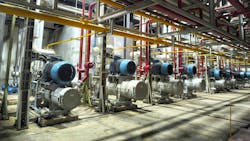How to Optimize Reciprocating Compressors for Efficiency and Reliability
Key Highlights
- Liquid in the gas stream can cause severe failures; therefore, filtration, scrubbers, and knockout vessels are vital for ensuring dry, clean gas intake.
- Capacity control methods include unloaders and clearance pockets, but variable clearances and variable-speed drives offer more reliable and efficient operation.
- Pulsation and vibration analysis, along with piping modifications, are crucial for preventing fatigue, reducing power consumption, and maintaining measurement accuracy.
Reciprocating compressors are commonly used for gas compression services in chemical processing plants.
Stricter environmental and energy regulations are driving chemical processing operators to push reciprocating compressors to new performance, efficiency, and reliability limits. To meet these evolving standards, plant operators must focus on critical design elements including cylinder valves, pulsation control, unloading systems, compressor control, flow resistance and thermal management throughout the compression system.
To gain a better understanding of these requirements, we must first look at how a reciprocating compressor works. It operates on a repeated reciprocating step cycle. The piston moves down on its suction stroke causing a flow of gas to enter the cylinder until the piston reaches the end of that stroke and then proceeds on its compression stroke.
At this point, the flow into that cylinder stops and stays there until the next suction stroke begins.
On the discharge side, as soon as the internal pressure reaches the level in the discharge port, along with the pressure required to open the cylinder discharge valve, the valve opens and gas starts to flow. When the piston reaches the end of the compression stroke, the discharge valve closes and the gas flow stops. This on-off flow process causes pulsation, noise and vibration in the discharge and suction ports and their connections and piping. The pulsation and associated vibrations is present in both suction and discharge facilities and piping.
Further Details on Reciprocating Compressors
The cylinders provide confinement for the gas during compression. A piston is driven in a reciprocating action to compress the gas. The arrangement may be of single-acting or double-acting cylinders. The double-acting, or dual-acting, cylinder is the most popular and most common type. In this configuration, compression occurs on both sides of the cylinder during both the advancing and retreating stroke.
The gas is drawn into the cylinder by suction valves, compressed, contained and then released by discharge valves. Cylinder valves are sophisticated, specially designed check valves that operate automatically by differential pressures.
The distance piece is a structural or mechanical member connecting the compressor frame to the cylinder(s).
It’s important to avoid intermixing fluids, such as compressed gas and lubrication oil, between the cylinder and the distance piece. Packing rings contain the gas pressure within the cylinder, and they keep lubrication oil from entering the cylinder by wiping oil from the piston rod along its travel. The packing rings are provided to contain the gas within the cylinder. Even so, a tiny amount of the compressed gas may leak past the packing rings. For this reason, sophisticated sealing and venting systems are necessary.
Areas of Concern
Factors impacting cylinder valves include valve dynamics, valve losses and reliability of cylinder valve components. Chemical operators have reported that these problems have led to short cylinder valve lifespans and unscheduled downtime.
For the compression process, re-expansion volume, heat transfer and blow-by through the clearances between the piston and cylinder wall are important factors. The gas flow resistance, friction loss, pulsation and vibration should also be considered for the entire reciprocating compressor package and surrounding infrastructure and piping.
Liquid in Compressing Gas
Another major cause of failure in reciprocating compressors is liquids or hydrates in the gas. Only very small amounts of liquid can be expelled through the discharge valve. Liquids remaining in the cylinders can cause problems, including valve failures. Other issues with liquid in the gas include unexpected high rod load and piston failure. The gas should be dry, clean and free from liquids, solids, dirt and impurities. The gas should be filtered, and then scrubber or knockout vessel should be installed at the suction of each stage. For very severe liquid carryover cases, other types of liquid separators, such as a cyclone separator, might be used. A cyclone separator utilizes the gas velocity and internal passages to create vortex separation but are not a popular option among many operators. Separators, knockout vessels and filters are considered to be more conventional choices. Operators also can employ line tracing and heating to raise the gas temperature to vaporize the entrained liquids.
Optimization and Key Parameters
Cost-effective operation of reciprocating compressors requires a balance among pulsation control, efficiency, reliability and performance. For instance, higher compressor speed typically correlates with a lighter, more compact compressor. On the other hand, higher speeds also lead to difficulties with high wear potential, sliding surfaces, reliability issues and dynamic problems. High-speed compressors can have more severe instances of acoustic excitation frequencies overlapping the acoustic and mechanical frequencies of different parts. such as passages and piping systems.
Compressor cylinders are often sized toward achieving balanced compression ratios across all stages. However, an alternative approach used by some compressor manufacturers is to refine sizing the cylinders and the reciprocating compressor based on maintaining balanced discharge temperatures across all stages. This is a popular option as the discharge temperature is a key parameter for the reliability of cylinder valves and overall reliability of the compressor.
Cylinder efficiencies also are important and are mainly related to gas passages and port configurations of cylinder valves. The design of cylinder passageways and valve details determines the magnitude of flow losses through the compression system.
Part-Load and Capacity Control
Cylinders may have one or multiple suction and discharge valves. Unloaders and clearance pockets are special devices that control the capacity (flow) carried by the compressor. Suction valve unloaders manipulate the suction valves’ action to allow the gas to recycle. Clearance pocket systems alter the cylinder head space (clearance volume).
They may be fixed or variable volume. Clearance pockets should usually be voided, particularly the variable volume clearance pockets, which could lead to some reliability and operational problems. Many operators dislike clearance pockets, although they have traditionally been used in many compressors. They have been associated with or perceived to be the source of many operational issues.
Variable clearances have very low reliability, mechanical problems and poor overall performance. An important decision in the compressor selection or renovation is whether to use cylinder fixed clearances or not. Cylinder fixed clearances are not popular either, but they may be used as the last option. In other words, ideally, cylinder fixed clearances shouldn’t be used since they could bring some reliability and operational problems. However, for some applications, the compressor arrangement and required capacity control is in a way that it mandates the use of cylinder fixed clearances. Typical fixed clearances for normal cylinders range from about 10%-25% of the total volume. It might not be appropriate to use the compressor with a clearance of less than 10%. Also, fixed clearances for 30% or more might only be used in special cases. However, they are not common nor popular. If needed, fixed clearances of 20% are acceptable.
Nowadays, reciprocating compressors using variable-speed drivers or stepless capacity control systems are available, as well, offering a wide range of operating points.
High-Speed Reciprocating Compressors
There is a trend toward the use of high-speed reciprocating compressors. But there are some limits and concerns. The high-speed compressors are sensitive to off-rated operation (operation different than the rated operation points). They are more vulnerable against pulsation issues, cylinder valve problems and other reciprocating compressor areas of concern.
High-speed reciprocating compressors can experience diminished cylinder performance and reliability due to higher-than-expected valve losses and pulsation levels. These high pulsations consequently contribute to the higher-than-anticipated vibration levels found on several high-speed reciprocating compressors.
Internal gas passage acoustics, cylinder-to-cylinder and cylinder-to-piping interactions and nonlinear flow losses have been challenging for some high-speed reciprocating compressors.
Variable-Speed Reciprocating Compressors
Theoretically, variable-speed operation is one of the desired options for the capacity control of a reciprocating compressor. Regarding variable-speed reciprocating compressors, the flow (capacity) varies approximately linearly with speed and clearance (suction volumetric efficiency). In other words, the capacity of a reciprocating compressor varies linearly with speed, which offers an excellent stepless and highly efficient capacity control opportunity.
Reciprocating compressors often have large load torque variations with every cycle. Some can be up to 50% of the average torque. The driver of such a compressor is slamming current in and out to keep-up with the transient torques. While using large flywheels or large rotor inertia to damp-out the load dynamics is always an option, usually alternative options should be investigated to achieve optimum purchase and operation costs. If the electric motor is being driven by a variable-speed drive (VSD) with sophisticated drive algorithms — for example, controllers that can track the load torque variations — then both the efficiency and transient stability problems can be solved together.
The other significant consideration is motor start-up. The transient high-load torque also is present at start-up, so the electric motor should be able to accelerate through the load transients and be capable of starting when the compressor is sitting at the highest load. Many traditional, large reciprocating compressors used VSD for the soft start-up.
A better option is to use VSD both for the start-up and variable-speed operation. Of course, the speed range should be set carefully considering all dynamic, mechanical and operational factors, such as torsional behavior and pulsation.
Although variable-speed reciprocating compressors are desired, smooth operation and high reliability can only be ensured with attention to all details, as there are many risks associated with this type of machinery, including torsional issues, pulsation and dynamic problems.
There have been some successful applications, but variable-speed reciprocating compressors are not established and reliable solutions for large critical services.
Pulsation and Vibration
Pulsation has always been a major issue with reciprocating compressors. Even when pulsations are within allowable levels, high vibration and cyclic stress levels can still occur. Pulsation and mechanical response analyses are needed for nearly all reciprocating compressors to keep the pulsation, shaking forces, dynamic effects and vibration within limits. The final aim of the pulsation review is the prevention of the following areas of difficulty:
- Unacceptable levels of pulsations and vibrations and cyclic stresses causing fatigue failure in the compressor, piping, supports or other items.
- Increased power consumption and capacity loss.
- Hammering of compressor valves, relief valves and check valves due to pulsations.
- Inaccuracies of flow-measuring devices.
Pulsation analysis of the piping and facilities should involve the precise modeling of the complete piping and facility system, including all details, such as T-joints, all valves (check valves, control valves, etc.) and equipment, such as heat exchangers and separators. The pulsations and pulsation-induced shaking forces are calculated and compared with allowable levels. If these are exceeded, possible modifications should be investigated. The following changes are frequently advised as necessary:
- Redesign of the piping.
- Increasing the diameter of some pipe sections.
- Relocating normally closed valves or other piping items or elements.
- Installing additional volume, such as secondary pulsation bottles.
It is more expensive and difficult to change pulsation bottles. A redesign of the pulsation bottles is usually not recommended. In general, in a revamp or renovation or other circumstances, the pulsation bottles are fabricated and already exist on site at the time of final pulsation review. There is no possibility to change them. However, piping is not usually completely fabricated at this stage, and they can be changed to some extent for better overall outcome.
About the Author
Amin Almasi
rotating equipment consultant
AMIN ALMASI is a mechanical consultant based in Sydney, Australia. He specializes in mechanical equipment and offers his insight on a variety of topics including pumps, condition monitoring, reliability, as well as powder and fluid handling and water treatment.

